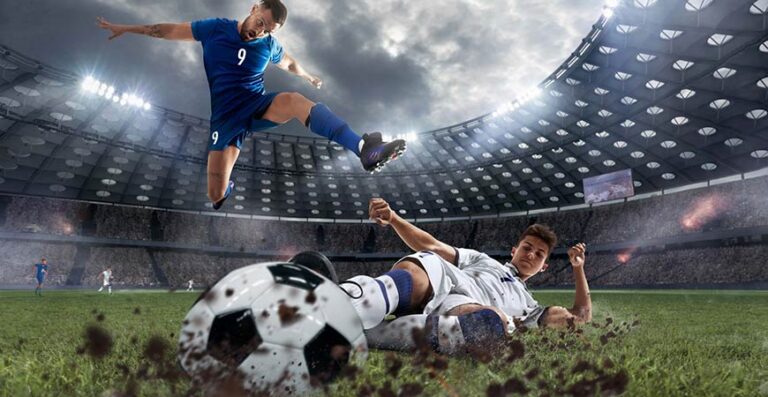
Whether you’re watching from home or cheering on your team in person, rest assured that technology will be helping to make this World Cup one to remember.
Technology is shaping the future of sports. FIFA World Cup Qatar 2022 is living proof that new technologies—from artificial intelligence (AI) referee assistance and outdoor stadium cooling systems—can surprise players and fans with a better experience in a once-traditional global sport. If you want to catch all the incredible changes happening to soccer right now, keep reading our post!
Sensor-equipped football
To ensure accurate decision-making for each match, FIFA officials this year are using the first ever football with a sensor, an Adidas “Al Rihla” (“the journey” in Arabic) ball. The new ball comes equipped with an inertial measurement unit (IMU) sensor, which helps make accurate offside calls. Placed at the center of the ball, the sensor sends data to the video operation room 500 times per second. Referees can then see where the ball was kicked from at any given time and will provide crucial evidence in tight offside decisions.
Things will get more exciting and advance past the quarterfinals. Adidas has introduced a new ball “Al Hilm” (“the dream” in Arabic) to replace Al Rihla in the semi-finals and finals of the FIFA World Cup 2022. Using water-based inks and glues, Al Hilm is more environmentally friendly. “Al Hilm represents a beacon of light on the power of sport and soccer to bring the world together,” said Adidas general manager Nick Craggs.
AI and more…
Video Assistant Referee (VAR) has seen its fair share of controversies in soccer. FIFA has taken a step further by rolling out a new AI-based semi-automated offside technology (SAOT). The stadiums in Qatar have 12 tracking cameras underneath the roof that can track the players and the ball’s positions 50 times per second. By monitoring players’ limbs and their extremities, authorities hope to make offside calls quicker and more accurately.
SAOT can work with the IMU sensor attached to the World Cup ball to compare the exact moment the ball is kicked with the position of the team’s last defender and the opposing team’s striker. This level of precision is essential for close situations where it can be difficult for the referee to make a good call.
This combination of technologies can turn things around, as demonstrated in Portugal’s matchup against Uruguay, where it was eventually determined that Bruno Fernandes scored Portugal’s opening goal instead of Cristiano Ronaldo.
“FIFA is committed to harnessing technology to improve the game of soccer at all levels, and the use of semi-automated offside technology at the FIFA World Cup in 2022 is the clearest possible evidence,” said FIFA President Gianni Infantino. Having been tested for three years already, the SAOT system is now “the most accurate offside support system available to video match officials”, according to FIFA.
Advanced stadium cooling technology
One of the first concerns people had with Qatar hosting the FIFA World Cup 2022 was harsh weather conditions. To circumvent this, seven out of the eight stadiums are equipped with solar-powered cooling technology designed by Saud Abdulaziz Ghani, or “Dr. Cool”, that can benefit the players, fans—from injuries and illnesses common under extreme heat—as well as the grass.
Besides having sensors installed to regulate the temperature, the stadium becomes a “completely isolated bubble”, with jet nozzles pumping out cool air at the pitch sides and under the spectator’s seats to keep it at 21 degrees Celsius. The rising warmer air then goes back into the cooling system and is cleaned by water at 7 degrees Celsius before being circulated back into the stadium again.
An app for FIFA players
Each World Cup player received a unique QR code that gave them access to the FIFA Player App, and 400 registered for it. The app allows them to access their individual and team data, including their physical performance and gameplay information collected through in-stadium tracking systems, after each match. With the app, players can then analyze their performance to improve in the next games.
Croatia star Luka Modrić is one of the players who signed up for this app and finds it helpful. “Sometimes similar things or scenarios will happen to you on the pitch in two separate games, so by using this app I can see what I did in that particular moment which was not good and try to correct it for the next game,” shared Luka Modrić.
As for soccer fans, they can use another app called “FIFA+” to access instant replays and highlights.
It’s clear from everything we’ve seen so far that the FIFA World Cup Qatar 2022 will be one of the most technologically-advanced sporting events in history. From AI to stadium design and fan experience, every aspect of this tournament is set to be groundbreaking. It’s an exciting time for soccer fans all over the world, and it’s clear that Qatar is doing everything it can to make this opportunity count
Also read:
Header image courtesy of Freepik